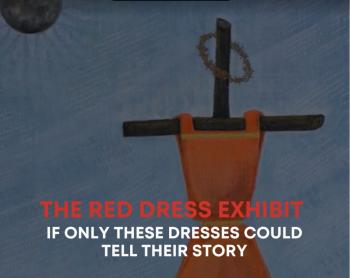Local Journalism Initiative Reporter
Windspeaker.com
The stories of 13 Indigenous women will be told through this weekend at the Robertson Theatre FirstOntario Performing Arts Centre in St. Catherines, Ont.
“The Red Dress Exhibit: If only these dresses could tell their story” project is focused on raising awareness about the violence that is perpetrated against Indigenous women, girls, and two-spirited people.
Michele-Elise Burnett, curator of the exhibit, said she was inspired to do the project by a song called Missing she had heard from a close friend, Kenny Lee Lewis from the Steve Miller Band, who had co-written it.
“The Red Dress project kind of came as a vision last year,” she said. “It started growing in my mind that we really need to create more awareness of the atrocities, and this is a reality. I kept getting thoughts of working with local women.”
Burnett put a call out to friends from upstate New York, as well as in the Niagara area, to see who would be willing to get involved to tell their story or the story of a family member.
As the project evolved, Burnett decided to base the project on the 13 grandmother moons and 28-day cycle of women.
The exhibit builds on the work of another artist, Jamie Black, who in 2010 created the Redress project. It showcased red dresses hanging empty to represent missing and murdered Indigenous women, the high number of which was horrifying.
“Indigenous women are 10 times more likely to go missing or murdered than any other race in North America,” said Burnett.
“That’s scary… It should not be.”
Burnett said she wanted to educate people about the unsafe world Indigenous women continue to live in.
Burnett’s Red Dress Exhibit tells 13 stories narrated by the families of the missing or murdered. A red dress, adorned with ribbons, beads or appliqué, or another piece of art on display, helps tell their stories with an accompanying downloadable documentary-style audio.
When attending the project, audiences will initially walk through a doorway that represents residential schools.
“We have a residential school door, which is where I start the story… Residential schools have directly affected all of us,” she said.
“When I put these narratives together, it’s like you go through a journey of all of these different lives. You will meet all of these spirits, and all of these dresses will tell their stories that day.”
The families “are bringing back the spirit of their loved one,” said Burnett. And for some, they are survivors themselves.
Fallon Farinacci, 33, is one of the individuals who contributed to the project. She represents an aspect of the issue that is often forgotten—the story of the children of the missing or murdered.
When Farinacci was nine years old, her parents, Maurice and Sherry Paul, were murdered by her mother’s stalker. She and her brother were held hostage for several hours before RCMP came to the scene.
“Being the fact that I’m a child survivor… it’s not necessarily talked about as much that there are children of those who have been murdered or gone missing.” She said her red dress will shine a light on that, ‘seeing it is a child’s dress,” said Farinacci, who is Red River Métis.
For many years she thought her story was unique, until she began to learn that there are others.
“When you’re in it you don’t realize anything, but you just think that’s your story. That’s my life,” she said.
When her parents were murdered, she was moved to Niagara to live with her mother’s family. She fought hard to return to her community in St. Eustache, Man. and she did return and graduated from high school there with her peers. When her grandfather fell ill, she went back to Niagara to care for him and ended up meeting her now husband and stayed in the area. She said she goes home to Manitoba often to visit her family.
Farinacci felt compelled to share her story, she said, in the hopes of educating others.
“With the dress and the story of it, it’s to bring awareness, to have those conversations for people to understand there’s so many layers to missing and murdered Indigenous women, girls, two-spirited LGBTQ+ and men,” she said.
“It is a child’s dress, so it’s going to represent myself, my nine-year-old self, but through the lens of also my father and the journey that I have been on over the last couple years of reclaiming my power and place.”
Burnett hopes the Red Dress Exhibit will eventually travel to destinations throughout Turtle Island, adding more stories like Farinacci’s to the collection.
“My concept is I want it to travel, but everywhere that we travel that we will bring in another family, another story, and we will bring another spirit, just introduce another spirit through the dress,” she said.
She hopes, as the spirits are able to share their stories, that the exhibit will lead to the lessening of crimes committed against Indigenous women, girls and gender-diverse peoples.
“No more stolen sisters. We all need to work together to end this horrific, systemic crisis that is going on in both the U.S. and Canada,” Burnett said.
The Red Dress Exhibit is part of the Celebration of Nations Indigenous arts gathering which began Sept. 9 and runs though Sept. 11. For a complete schedule visit Celebration of Nations | 9-11 September 2022
Local Journalism Initiative Reporters are supported by a financial contribution made by the Government of Canada.

